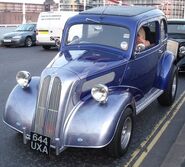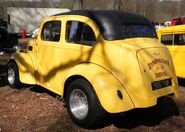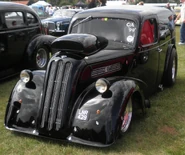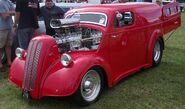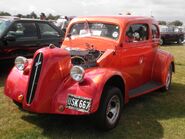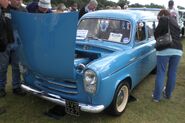(Editing a gallery) |
m (Marking navigational galleries) |
||
| (38 intermediate revisions by 5 users not shown) | |||
| Line 1: | Line 1: | ||
| − | + | [[File:Ford_Pop.JPG|thumb|322px|Ford Popular]] |
|
| + | The '''Ford Popular''' is best known as a car from Ford built in England between 1953 and 1962. When launched, it was Britain's lowest priced car. |
||
| − | The name Popular was also used by Ford to describe its 1930s Y Type model. The Popular name was also later used on basic models of the Escort and Fiesta cars. |
+ | The name Popular was also used by Ford to describe its 1930s [[Ford Model Y|Y Type]] model. The Popular name was also later used on basic models of the Escort and Fiesta cars. |
==Ford Popular 103E== |
==Ford Popular 103E== |
||
| − | When production of the older Ford Anglia and Ford Prefect was stopped in 1953 the Popular was developed as a budget alternative. The Popular was based on the old, prewar-style E494A Anglia. It was powered by a Ford Sidevalve 1172 cc, 30 bhp (22 kW), four cylinder engine. The car was very basic. It had a single vacuum powered wiper, no heater, vinyl trim and very little chrome, even the bumpers were painted. Over 150,000 Populars were made. |
+ | When production of the older [[Ford Anglia]] and [[Ford Prefect]] was stopped in 1953 the Popular was developed as a budget alternative. The Popular was based on the old, prewar-style E494A Anglia. It was powered by a Ford Sidevalve 1172 cc, 30 bhp (22 kW), four cylinder engine. The car was very basic. It had a single vacuum powered wiper, no heater, vinyl trim and very little chrome, even the bumpers were painted. Over 150,000 Populars were made. |
This car proved successful because, while on paper it was a sensible alternative to a clean, late-model used car, in practice there were no clean late-model used cars available in postwar Britain due to the six-year halt in production caused by World War II. This problem was compounded by stringent export quotas that made obtaining a new car in the late 1940s and into the early 1950s difficult, and covenants forbidding new-car buyers from selling for up to three years after delivery. Unless the purchaser could pay the extra £100 or so for an Anglia 100E, Austin A30 or Morris Minor, the choice was the Popular or a prewar car. |
This car proved successful because, while on paper it was a sensible alternative to a clean, late-model used car, in practice there were no clean late-model used cars available in postwar Britain due to the six-year halt in production caused by World War II. This problem was compounded by stringent export quotas that made obtaining a new car in the late 1940s and into the early 1950s difficult, and covenants forbidding new-car buyers from selling for up to three years after delivery. Unless the purchaser could pay the extra £100 or so for an Anglia 100E, Austin A30 or Morris Minor, the choice was the Popular or a prewar car. |
||
| Line 10: | Line 11: | ||
===The 103E in Australia=== |
===The 103E in Australia=== |
||
The Popular 103E was introduced into the Australian market in 1953 but not with the British two door saloon body style. Instead, it was offered as a two door Tourer, a two door Roadster Utility and as a two door Coupe Utility. The Tourer was a re-badged Anglia 103E Tourer and the Roadster Utility, which featured a step-side body, was called a Plumber's Utility. |
The Popular 103E was introduced into the Australian market in 1953 but not with the British two door saloon body style. Instead, it was offered as a two door Tourer, a two door Roadster Utility and as a two door Coupe Utility. The Tourer was a re-badged Anglia 103E Tourer and the Roadster Utility, which featured a step-side body, was called a Plumber's Utility. |
||
| ⚫ | |||
| ⚫ | |||
| + | 100_2642.JPG|1954 Ford Popular 103E rat rod|link=http://www.flickr.com/photos/59728935@N07/6103589339/ |
||
| ⚫ | |||
| + | Ford Pop.jpg|Ford Popular 103E custom |
||
| ⚫ | |||
| + | Wheels day 2012 011.JPG|Ford Popular 103E |
||
| + | Wheels day 2012 028.JPG|Ford Popular 103E custom |
||
| + | DSC08624.JPG|Ford Popular 103E |
||
| + | DSC09300.JPG|Ford Popular 103E |
||
| + | Car etc 025.JPG|Ford Popular 103E |
||
| + | DSC00076.JPG|Ford Popular 103E |
||
| + | Black Ford Pop.JPG|Ford Popular 103E custom |
||
| + | DSC09990.JPG|Ford Popular 103E |
||
| + | Nationals 2012 001.JPG|Ford Popular 103E custom |
||
| + | DSC00286.JPG|Ford Popular Hotrod 103E custom |
||
| + | Nationals 2012 059.JPG|Ford Popular 103E custom |
||
| + | Nationals 2012 050.JPG|Ford Popular 103E custom |
||
| + | assorted snaps 756.JPG|Ford Popular 103E custom |
||
| + | assorted snaps 846.JPG|Ford Popular 103E custom |
||
| + | P3290019 (2).JPG|Ford Popular 103E |
||
| + | P8260119 (2).JPG|Ford Popular 103E |
||
| + | P5040100.JPG|Ford Popular 103E Pickup |
||
| + | P6090106 (2).JPG|Ford Popular 103E custom |
||
| + | P6090070.JPG|Forf Popular 103E custom |
||
| + | assorted snaps 830.JPG|Ford Popular 103E custom |
||
| + | </gallery> |
||
==Ford Popular 100E== |
==Ford Popular 100E== |
||
In 1959 the old Popular was replaced by a new version that was in production until 1962. Like the previous version it used a superseded Anglia's body shell, this time that of the 100E, and it was powered by a strengthened 1172 cc sidevalve engine producing 36 bhp. The brakes were now hydraulic with 7.1 in (180 mm) drums all round. The new Poplar offered 1,000 (1,500) service intervals, like its predecessor, but it only had 13 grease points as against its predecessor's 23 (or 28 for the pre-war cars). The basic model stripped out many fittings from the Anglia but there was a large list of extras available and also a De Luxe version which supplied many as standard. |
In 1959 the old Popular was replaced by a new version that was in production until 1962. Like the previous version it used a superseded Anglia's body shell, this time that of the 100E, and it was powered by a strengthened 1172 cc sidevalve engine producing 36 bhp. The brakes were now hydraulic with 7.1 in (180 mm) drums all round. The new Poplar offered 1,000 (1,500) service intervals, like its predecessor, but it only had 13 grease points as against its predecessor's 23 (or 28 for the pre-war cars). The basic model stripped out many fittings from the Anglia but there was a large list of extras available and also a De Luxe version which supplied many as standard. |
||
| Line 18: | Line 46: | ||
In 1960, the manufacturer's recommended retail price of £494 was equivalent to 26 week's worth of the average UK wage. The £100 charged in 1935 and the £1,299 charged for the Ford Escort Popular in 1975 both also amounted to 26 week's worth of average wage for the years in question. In the 1950s, however, the country had been undergoing a period of above average austerity: in 1953 the car's £390 sticker price represented 40 week's worth of the average UK wage. |
In 1960, the manufacturer's recommended retail price of £494 was equivalent to 26 week's worth of the average UK wage. The £100 charged in 1935 and the £1,299 charged for the Ford Escort Popular in 1975 both also amounted to 26 week's worth of average wage for the years in question. In the 1950s, however, the country had been undergoing a period of above average austerity: in 1953 the car's £390 sticker price represented 40 week's worth of the average UK wage. |
||
| + | ===Gallery=== |
||
| + | <gallery> |
||
| + | DSC00040.JPG|Ford Popular 100E |
||
| + | DSC07784.JPG|Ford Popular 100E Deluxe |
||
| + | Nationals 2012 014.JPG|Ford Pop 100E |
||
| + | assorted snaps 875.JPG|Ford Popular 100E |
||
| + | Nationals 2012 042.JPG|Ford Popular 100E custom |
||
| + | Nationals 2012 022.JPG|Ford Popular 100E |
||
| + | assorted snaps 961.JPG|Ford Popular 100E |
||
| + | </gallery> |
||
| + | |||
==Popular trim level== |
==Popular trim level== |
||
In 1975 the Popular name was revived as a base trim level of the newly released Ford Escort Mk2. This model featured a standard 1.1 litre OHV Kent motor, 12 inch wheels with cross ply tyres and drum brakes all round. The 1975 Ford Escort Popular was the first Ford to carry the Popular name that also featured a heater as standard equipment. The "Popular" trim level proved long-standing across the Ford range, featuring on later Escorts and the Fiesta, from 1980 to 1991. |
In 1975 the Popular name was revived as a base trim level of the newly released Ford Escort Mk2. This model featured a standard 1.1 litre OHV Kent motor, 12 inch wheels with cross ply tyres and drum brakes all round. The 1975 Ford Escort Popular was the first Ford to carry the Popular name that also featured a heater as standard equipment. The "Popular" trim level proved long-standing across the Ford range, featuring on later Escorts and the Fiesta, from 1980 to 1991. |
||
==Ford Popular in television shows== |
==Ford Popular in television shows== |
||
In 1970, a Ford Popular was extensively modified by the British Broadcasting Corporation to become "Bessie", the Doctor's sprightly Edwardian roadster on the long-running science-fiction television show, ''Doctor Who''. A black Ford Popular 103E (EBW 343) was also used in the ''Monty Python's Flying Circus'' sketch ''Mr. and Mrs. Brian Norris' Ford Popular''. In a spoof of epic journeys, the Norrises (Michael Palin as Brian Norris and Graham Chapman in drag as Betty Norris) set out to see if the journey from Surbiton to Hounslow was possible; they were thwarted by the Thames and had to finish the trek by rail. Between 1992 and 1997, two black Ford Populars (8253 PU and VXL 794) were used in ''Heartbeat'' as Oscar Blaketon's car, the trim corrodes a bit but still in good repair for its age. |
In 1970, a Ford Popular was extensively modified by the British Broadcasting Corporation to become "Bessie", the Doctor's sprightly Edwardian roadster on the long-running science-fiction television show, ''Doctor Who''. A black Ford Popular 103E (EBW 343) was also used in the ''Monty Python's Flying Circus'' sketch ''Mr. and Mrs. Brian Norris' Ford Popular''. In a spoof of epic journeys, the Norrises (Michael Palin as Brian Norris and Graham Chapman in drag as Betty Norris) set out to see if the journey from Surbiton to Hounslow was possible; they were thwarted by the Thames and had to finish the trek by rail. Between 1992 and 1997, two black Ford Populars (8253 PU and VXL 794) were used in ''Heartbeat'' as Oscar Blaketon's car, the trim corrodes a bit but still in good repair for its age. |
||
| + | |||
| ⚫ | |||
| + | ==Evolution of the Ford Popular== |
||
| ⚫ | |||
| + | <gallery type="slideshow" position="center"> |
||
| ⚫ | |||
| − | + | DSC09300.JPG|Ford Popular 103E |
|
| + | DSC00040.JPG|Ford Popular 100E |
||
| ⚫ | |||
</gallery> |
</gallery> |
||
| + | {{Ford of Britain}} |
||
[[Category:Ford]] |
[[Category:Ford]] |
||
[[Category:Post-war]] |
[[Category:Post-war]] |
||
| + | [[Category:Ford of Britain]] |
||
| + | [[Category:Ford of Europe]] |
||
| + | [[Category:Ford of Australia]] |
||
Latest revision as of 21:46, 21 August 2014
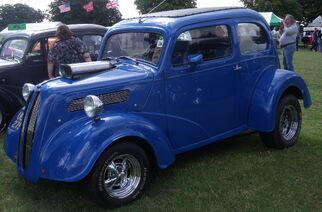
Ford Popular
The Ford Popular is best known as a car from Ford built in England between 1953 and 1962. When launched, it was Britain's lowest priced car.
The name Popular was also used by Ford to describe its 1930s Y Type model. The Popular name was also later used on basic models of the Escort and Fiesta cars.
Ford Popular 103E
When production of the older Ford Anglia and Ford Prefect was stopped in 1953 the Popular was developed as a budget alternative. The Popular was based on the old, prewar-style E494A Anglia. It was powered by a Ford Sidevalve 1172 cc, 30 bhp (22 kW), four cylinder engine. The car was very basic. It had a single vacuum powered wiper, no heater, vinyl trim and very little chrome, even the bumpers were painted. Over 150,000 Populars were made.
This car proved successful because, while on paper it was a sensible alternative to a clean, late-model used car, in practice there were no clean late-model used cars available in postwar Britain due to the six-year halt in production caused by World War II. This problem was compounded by stringent export quotas that made obtaining a new car in the late 1940s and into the early 1950s difficult, and covenants forbidding new-car buyers from selling for up to three years after delivery. Unless the purchaser could pay the extra £100 or so for an Anglia 100E, Austin A30 or Morris Minor, the choice was the Popular or a prewar car.
A car tested by The Motor magazine in 1954 had a top speed of 60.3 mph (97.0 km/h) and could accelerate from 0-50 mph (80 km/h) in 24.1 seconds. A fuel consumption of 36.4 miles per imperial gallon (7.76 L/100 km; 30.3 mpg-US) was recorded. The test car cost £390 including taxes.
The 103E in Australia
The Popular 103E was introduced into the Australian market in 1953 but not with the British two door saloon body style. Instead, it was offered as a two door Tourer, a two door Roadster Utility and as a two door Coupe Utility. The Tourer was a re-badged Anglia 103E Tourer and the Roadster Utility, which featured a step-side body, was called a Plumber's Utility.
Gallery
Ford Popular 100E
In 1959 the old Popular was replaced by a new version that was in production until 1962. Like the previous version it used a superseded Anglia's body shell, this time that of the 100E, and it was powered by a strengthened 1172 cc sidevalve engine producing 36 bhp. The brakes were now hydraulic with 7.1 in (180 mm) drums all round. The new Poplar offered 1,000 (1,500) service intervals, like its predecessor, but it only had 13 grease points as against its predecessor's 23 (or 28 for the pre-war cars). The basic model stripped out many fittings from the Anglia but there was a large list of extras available and also a De Luxe version which supplied many as standard.
In later years, these cars became popular as hot rods since the late 1950s when people started drag racing them due to their light weight construction. Ironically this started in the United States but became the definitive British hot rod, which it still is today.
The Motor magazine tested a 100E in 1960 and found it to have a top speed of 69.9 mph (112.5 km/h), acceleration from 0-50 mph (80 km/h) in 19.6 seconds and a fuel consumption of 33.2 miles per imperial gallon (8.51 L/100 km; 27.6 mpg-US). The test car cost £494 including taxes with a comment that it was the lowest priced orthodox saloon on the British Market.
In 1960, the manufacturer's recommended retail price of £494 was equivalent to 26 week's worth of the average UK wage. The £100 charged in 1935 and the £1,299 charged for the Ford Escort Popular in 1975 both also amounted to 26 week's worth of average wage for the years in question. In the 1950s, however, the country had been undergoing a period of above average austerity: in 1953 the car's £390 sticker price represented 40 week's worth of the average UK wage.
Gallery
Popular trim level
In 1975 the Popular name was revived as a base trim level of the newly released Ford Escort Mk2. This model featured a standard 1.1 litre OHV Kent motor, 12 inch wheels with cross ply tyres and drum brakes all round. The 1975 Ford Escort Popular was the first Ford to carry the Popular name that also featured a heater as standard equipment. The "Popular" trim level proved long-standing across the Ford range, featuring on later Escorts and the Fiesta, from 1980 to 1991.
Ford Popular in television shows
In 1970, a Ford Popular was extensively modified by the British Broadcasting Corporation to become "Bessie", the Doctor's sprightly Edwardian roadster on the long-running science-fiction television show, Doctor Who. A black Ford Popular 103E (EBW 343) was also used in the Monty Python's Flying Circus sketch Mr. and Mrs. Brian Norris' Ford Popular. In a spoof of epic journeys, the Norrises (Michael Palin as Brian Norris and Graham Chapman in drag as Betty Norris) set out to see if the journey from Surbiton to Hounslow was possible; they were thwarted by the Thames and had to finish the trek by rail. Between 1992 and 1997, two black Ford Populars (8253 PU and VXL 794) were used in Heartbeat as Oscar Blaketon's car, the trim corrodes a bit but still in good repair for its age.
Evolution of the Ford Popular
| Ford of Britain vehicles | ||
|---|---|---|
| Ford | ||
| Classic production cars | 1900s | Model T |
| 1910s-1920s | Model A | |
| 1930s-1940s | Model B • Model Y • Model 48 • Model 91 • Model C Ten • Model 7W • Model 7Y • Prefect • Anglia • Pilot | |
| 1950s | Consul • Popular • Squire • Zephyr | |
| 1960s | Capri • Corsair • Classic • Cortina • Escort • GT40 | |
| 1970s | Granada | |
| 1980s | Orion • RS200 • Sierra • Sierra RS Cosworth | |
| Classic commercial vehicles
|
A-Series • Model AA • Model BB • Model TT • Cargo • D-Series • E83W • R-Series • Thames 300E • Thames 307E • Thames 400E • Thames 7V • Thames ET • Transcontinental • Transit • Trader | |




